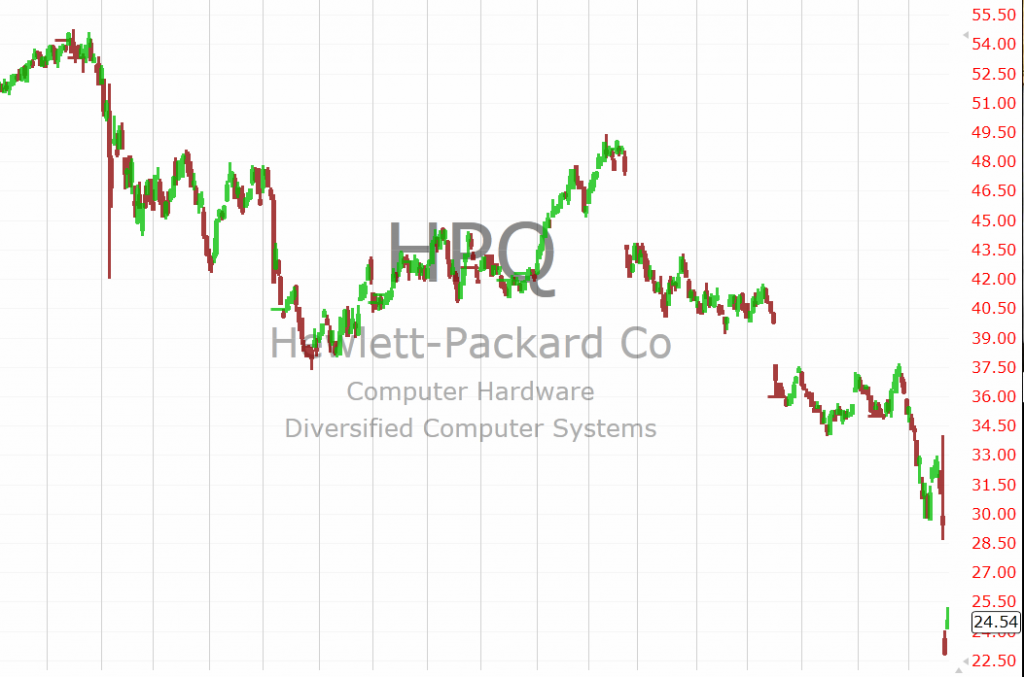I have no idea how much brokerage firms pay analysts to cover stocks or whether or not the costs are really offset by revenues from institutional trading. I’m assuming that whatever they pay them, it is money well spent and they make more than enough in reciprocal brokerage profits – because how else to explain it otherwise?
The vast majority of Wall Street’s equity coverage is a complete and total failure for investors seeking to invest based on the either the buy and sell calls, the price targets, the shifts in ratings or the insights.
Morgan Stanley‘s recent coverage of l’affaire du Hewlett-Packard ($HPQ) is an excellent case in point. I certainly don’t mean to pick on MS, as this is only one very glaring example of an industry-wide game that they are simply playing into.

This past Friday (8/19/2011) after the close of trading, following a 20% one-day crash to 23.60, Morgan Stanley analyst Kathy Hulberty decides to finally pull out the ne’er used Sell Rating on Hewlett-Packard. This comes after years carrying the company as an Overweight while the company repeatedly “beat earnings” under Mark Hurd by starving R&D, something any serious technology company analyst should have picked up on. Hulberty reiterated this Overweight rating in April 2010 on the news of the Palm acquisition (which has just been capped off by a billion dollar write-down and an admission that the purchase was a complete folly).
April 28th 2010:
“We believe HP’s acquisition of Palm makes long-term strategic sense,” said Morgan Stanley analysts Katy Huberty and Mathew Schneider in a report. “HP will gain control of the WebOS platform – a strategic (and scarce) asset that can be leveraged across multiple devices with attractive growth characteristics.”
Morgan Stanley maintains its Overweight/Attractive rating on HP that day even while removing the stock from it’s Top 10 list (so it’s an Overweight but not that much of an Overweight – like right after Kirstie Alley undergoes stomach stapling surgery).
Within a week the stock breaks major support below $50, a level at which a deaf, dumb and blind Pinball Wizard from Brighton could have told you signaled a major change in the supply-demand picture for the stock. I’m not saying that technical analysis trumps fundamental analysis all the time, but when the buyers don’t show up where they’re supposed to on the heels of a “transformative” acquisition announcement, it shouldn’t be expecting too much for a big-firm analyst to wake up to the possibility that there are more worthwhile inputs than her own discounted-cash-flow-analysis-sum-of-the-parts wishful thinking.
But Kathy waits until May of 2011 to cut HPQ to an “Equal Weight”, as if that language carries any actual meaning in the stock market. This after an endless series of earnings warnings and sales shortfalls and executive sex scandals. But fine, so Morgan Stanley’s clients have been told to overweight the stock (yes, it’s a verb not just a descriptive adjective) through a period of time in which it drops 20 points in an otherwise benign tape for tech stocks. And then they are told to Equal Weight from then on. From May of 2011 through Friday, August 19th, those Equal-Weighting clients are sitting in HPQ and they end up being almost cut in half again after the original drubbing.
A complete and total bloodbath for investors while Kathy sits on conference calls asking management for “more color” on day sales outstanding or whatever.
And as if that weren’t enough, on Friday night with markets closed and the damage done, they get the sell call de facto sell call (cutting guidance, outlook etc). In making it after market hours, Ms Hulberty & Co get to lock in the Friday close as their “sell outlook-cut price” even though no one reading the report could actually sell it then. Which makes total sense when you consider the fact that no one should be following buy and sell recs from The Street as actionable research anyway. In fact, the best way to think about these “calls” is as an advertisement for the 2 and 3 cent per share business the trading desks at these firms hope to do with hedge funds, mutual funds and pension funds.
I bring this brief history of Morgan Stanley’s “research coverage” of Hewlett-Packard to your attention as just one of thousands of examples of this kind of non-productive work coming from Wall Street. Which brings us back to the original question posed at the beginning of this post…is any of this profitable? The answer has to be yes, otherwise, it simply wouldn’t continue this way for as long as it has. The answer must be that the analysts are really being paid to appear in print and on conference calls representing the firm itself.
My suggestion for The Street would be to start referring to their equity analysts as “business analysts”. This would remove any expectation of them actually making helpful stock market calls and allow them to go about their true purpose of burnishing the firm’s image. It would also stop them from hurting anyone anymore.
Repeat after me: “Sell-side brokerage equity research is marketing.”




… [Trackback]
[…] Information to that Topic: thereformedbroker.com/2011/08/22/adventures-in-sell-side-research-hewlett-packard-edition/ […]
… [Trackback]
[…] Read More Information here to that Topic: thereformedbroker.com/2011/08/22/adventures-in-sell-side-research-hewlett-packard-edition/ […]
… [Trackback]
[…] Find More here on that Topic: thereformedbroker.com/2011/08/22/adventures-in-sell-side-research-hewlett-packard-edition/ […]
… [Trackback]
[…] Find More to that Topic: thereformedbroker.com/2011/08/22/adventures-in-sell-side-research-hewlett-packard-edition/ […]
… [Trackback]
[…] There you will find 72744 additional Information to that Topic: thereformedbroker.com/2011/08/22/adventures-in-sell-side-research-hewlett-packard-edition/ […]